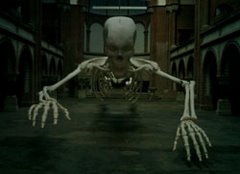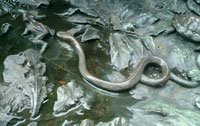 The ancestor of the wombat, the diprotodon "existed from 1.6 million years ago until about 40,000 years ago". The 2.5 tonne wombat-like Diprotodon was 1.8 metres tall and 3.5 metres long. Kangaroos reached 2.5m height at that time.
The ancestor of the wombat, the diprotodon "existed from 1.6 million years ago until about 40,000 years ago". The 2.5 tonne wombat-like Diprotodon was 1.8 metres tall and 3.5 metres long. Kangaroos reached 2.5m height at that time.The wombat today is a surviving shrunk-down version of this mega fauna. 100 % vegetarian, it eats mainly grasses and roots. Home is a burrow which they defend fiercely.
The problem today is, that they are running out of a habitat, or it is fragmented and criss-crossed by roads and dangerous vehicles. Additionally, it has to compete with all the invasive species that have been introduced to Australia.
Formally protected in its habitat, mainly 'National Parks', it seems ignorant of human real estate and w
 anders great distances to be a wombat. Private landholders of the South Coast and Southern Highland do not wish to share and asked to shoot the 'intruders'. 'Property damage' was a 'knock-me-dead' argument to the wombat's guardians, the National Parks and they handed out 200 licences to shoot the marsupials this year. "Most of these shooting licences are restricted to 10 or 20 animals and that can be the whole wombat population that is on a particular farm"
anders great distances to be a wombat. Private landholders of the South Coast and Southern Highland do not wish to share and asked to shoot the 'intruders'. 'Property damage' was a 'knock-me-dead' argument to the wombat's guardians, the National Parks and they handed out 200 licences to shoot the marsupials this year. "Most of these shooting licences are restricted to 10 or 20 animals and that can be the whole wombat population that is on a particular farm"Soon tourists wishing to see the iconic wildlife of the area, will only be able to view the impeccable fences and pipes of private properties. An alternative would be to bestow effective protection on to the native fauna and require, vineyards and other private enterprises to install appropriate fences to signal their unwillingness to share the land with the indigenous fauna.
Update:
And the slaughter continues:
'Farmers are illegally slaughtering thousands of wombats in South Australia. Burrows of southern hairy-nosed wombats are being bulldozed or blown up on Yorke and Eyre Peninsulas and in the Murraylands. Farmers can get permits to destroy a few wombats, but that it not a licence to wipe out the entire population. Mass killings with petrol bombs or bulldozing'.. abc 011009
Update:
Ten wombats, including four feeding mothers, deliberately run over at Kangaroo Valley camping ground, NSW Police say abc, 10.09.2015
Images:
1. Wombat and Thylacine (Tasmanian Tiger), lithograph, 1878, via Wikimedia Commons
2. John Gould, Vombatus ursinus,"Mammals of Australia", Vol. I Plate 55, 1863, via Wikimedia Commons








No comments:
Post a Comment